-

新人教版高中英语必修3Unit 3 Diverse Cultures教学设计一
Activity 81.Grasp the main idea of the listening.Listen to the tape and answer the following questions:Who are the two speakers in the listening? What is their relationship?What is the main idea of the first part of the listening? How about the second part?2.Complete the passage.Ask the students to quickly review the summaries of the two listening materials in activity 2. Then play the recording for the second time.Ask them to complete the passage and fill in the blanks.3.Play the recording again and ask the students to use the structure diagram to comb the information structure in the listening.(While listening, take notes. Capture key information quickly and accurately.)Step 8 Talking Activity 91.Focus on the listening text.Listen to the students and listen to the tape. Let them understand the attitudes of Wu Yue and Justin in the conversation.How does Wu Yue feel about Chinese minority cultures?What does Justin think of the Miao and Dong cultures?How do you know that?2.learn functional items that express concerns.Ask students to focus on the expressions listed in activity. 3.And try to analyze the meaning they convey, including praise (Super!).Agree (Exactly!)"(You're kidding.!)Tell me more about it. Tell me more about it.For example, "Yeah Sure." "Definitely!" "Certainly!" "No kidding!" "No wonder!" and so on.4.Ask the students to have conversations in small groups, acting as Jsim and his friends.Justin shares his travels in Guizhou with friends and his thoughts;Justin's friends should give appropriate feedback, express their interest in relevant information, and ask for information when necessary.In order to enrich the dialogue, teachers can expand and supplement the introduction of Miao, dong, Lusheng and Dong Dage.After the group practice, the teacher can choose several groups of students to show, and let the rest of the students listen carefully, after listening to the best performance of the group, and give at least two reasons.

新人教版高中英语必修2Unit 1 Cultural Heritage-Discovering Useful Structure教案一
This teaching period mainly deals with grammar “restrictive relative clauses.” To begin with, teachers should lead students to revise what they have learned about the relative pronouns and relative adverbs. And then, teachers move on to stress more special cases concerning this grammar, such as the “preposition+ relative pronouns which and whom” and cases where we can omit the relative pronouns. This period carries considerable significance to the cultivation of students’ writing competence and lays a solid foundation for the basic appreciation of language beauty. The teacher is expected to enable students to master this period thoroughly and consolidate the knowledge by doing some exercises. 1. Guide students to review the basic usages of relative pronouns and adverbs of attributive clauses.2. Lead students to learn to use some special cases concerning restrictive relative clauses flexibly.2. Enable students to use the basic phrases structures flexibly.3. Strengthen students’ great interest in grammar learning.1. Help students to appreciate the function of relative pronouns and adverbs of attributive clauses in a sentence2. Instruct students to write essays using the proper relative pronouns and adverbs of attributive clauses.本节语法思考:定语从句在复合句中的作用是什么? 关系词有哪些?定语从句在复合句中的作用相当于形容词,它在句中作定语修饰名词或代词。他们在先行词和定语从句之间起到联系作用,同时在意义上代表先行词并在定语从句中担任一个成分。被定语从句所修饰的词称先行词,定语从句一般放在先行词的后面。

新人教版高中英语必修2Unit 3 The Internet-Discovering Useful Structure教案一
This unit is about the Internet, which has a great influence to our humans and our lives. During the Listening & Speaking & Talking and Reading and Thinking section, the influence in examples has been shown. Thus, use the Present Perfect Tense is appropriate. However, in order to show the justice or weaken the doer of the behavior/action, it’s better to use the Present Perfect Passive Voice than the Present Perfect Tense. Besides, having learned to use the Present Perfect Passive Voice, students can beautify their language in their writing. 1. Learn the structure of the Present Perfect Passive Voice and its functions. 2. Learn to change the sentences with the Present Perfect Passive Voice into the sentences with the Present Perfect Passive Voice. 3. Learn to write sentences with the Present Perfect Passive Voice flexibly according to the context. 1. Learn the structure of the Present Perfect Passive Voice and its functions. 2. Learn to change the sentences with the Present Perfect Passive Voice into the sentences with the Present Perfect Passive Voice. 3. Learn to write sentences with the Present Perfect Passive Voice flexibly according to the context. Step 1 Observe the following sentences, then change the sentences into passive voice.He has been selected to take part in the sports meeting.(肯定句)他已被挑选出来参加运动会。The ink has not been removed from his overcoat.(否定句)墨迹还没有从他外套上去掉。

新人教版高中英语必修2Unit 5 Music-Discovering Useful Structures教案一
Step1:自主探究。1.(教材P52)Born(bear) in the USA on 2 January 1970, Whitacre began studying music at the University of Nevada in 1988.2.(教材P52) Moved(move) by this music, he said, “It was like seeing color for the first time.”3.(教材P56)I was very afraid and I felt so alone and discouraged(discourage).4.(教材P58)Encouraged(encourage) by this first performance and the positive reaction of the audience, I have continued to play the piano and enjoy it more every day.Step2:语法要点精析。用法1:过去分词作表语1).过去分词可放在连系动词be, get, feel, remain, seem, look, become等之后作表语,表示主语所处的状态Tom was astonished to see a snake moving across the floor.汤姆很惊讶地看到一条蛇正爬过地板。Finally the baby felt tired of playing with those toys.终于婴儿厌倦了玩那些玩具。注意:1).过去分词作表语时与被动语态的区别过去分词作表语时,强调主语所处的状态;而动词的被动语态表示主语是动作的承受者,强调动作。The library is now closed.(状态)图书馆现在关闭了。The cup was broken by my little sister yesterday.(动作)昨天我妹妹把杯子打碎了。2)感觉类及物动词的现在分词与过去分词作表语的区别过去分词作表语多表示人自身的感受或事物自身的状态,常译作“感到……的”;现在分词多表示事物具有的特性,常译作“令人……的”。

新人教版高中英语必修2Unit 5 Music-Reading For Writing教案一
(4)Now we have heard a number of outstanding speeches ... 我们已经聆听了许多精彩的发言……(5)Because we wanted the nations of the world, working together, to deal with ... 因为我们希望全世界各国团结起来去应对……(6)And if we do not act ... 如果我们不采取行动……(7)Now, I share the concerns that have been expressed ... 我也同意对于……表达的担心(8)Let us show the world that by working together we can ... 让我们告诉全世界,通过一起努力我们可以……(9)It is now time for us to ... 是时候我们……(10)And I have always wished that ... 我一直希望……(11)Thank you for letting me share this day with me.感谢你们和我共度这一天。实践演练:假如你是高中生李华,你校将举办一次以“音乐”为主题的演讲比赛,请你按照主题,写下你的演讲稿。注意:词数100左右。First of all, thank you for listening to my speech. My topic is: love music like love yourself.Music is like the air we need to maintain our normal lives around us. You can't imagine how terrible a world without music would be. Movies and TV shows have no music, only dry conversations and scenes; mobile phones only vibrations; streets only noisy crowds; cafes, western restaurants only depressed meals. What a terrible world it is!As a student, I hope we all can enjoy the fun brought by music in our spare time. Instead of just listening to music, we can even make our own music. Let's enjoy the fun of music!Thanks again for your attention!

人教版新课标PEP小学英语六年级上册I Have a Pen Pal教案
(1)教师说:“Zhang Peng’s mother is a teacher.What does she teach? Does she teach English?”教师出示Let’s talk部分的挂图,放录音,学生听录音阅读对话。教师出示主句型:Does he/she…?Yes,he/she does.No,he/she doesn’t.然后教师引导学生回答刚刚提出的问题,逐步掌握肯定和否定回答。再放一遍, 学生跟读. (2)教师说:“My mother is a teacher,too.Do you want to know more about her.Ask me some questions.”教师依次出示B Let’s learn部分的单词卡片,提示学生根据上面的短语和黑板上的重点句型提问,教师作答。 (3)教师指导学生进行替换练习。必要时,提示学生可以换一下对话里的人物,f 如:Does your uncle live in the city? Yes,he does.Does your grandma live in the country? No,she doesn’t. (4)“寻找家园”游戏 教师准备一些卡片,正面写有人名,反面写有地名,如:city,country,village,farm,forest,mountain,nature park等。请一名学生上台抽取一张卡片,问台一学生:“Guess.Where does…live?’’学生猜:“Does he/she live in/on…?”猜对的小组得一分。
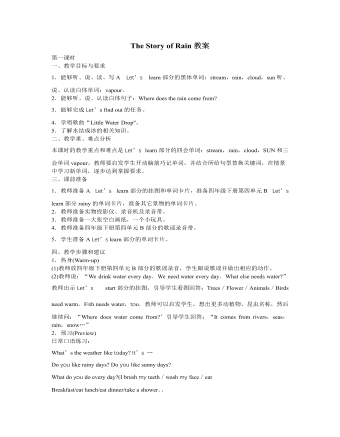
人教版新课标PEP小学英语六年级上册The Story of Rain教案
(2)教师说:“I am going to plant a flower on the weekend.But I don’t know hoⅥ do that.Can you tell me? Who knows?”教师提示学生可以适当用中文解释。如果有学生举手,教师就问:“OK.How d0 you do that?”引导学生回答。“First,put the seeds in the soil.”然后,教师接着说:“What should I do then? 引导学生回答“Water it. (3)教师说:“Zhang Peng is talking to h is teacher.Now Let’s see what they talking about.”学生翻开学生用书,教师放录音,学生跟读。教师解释In several days的意思是几天以后。”教师板书四会句型:How do you do that? What should you do then?学生仿写。 (4)同桌学生进行对话替换操练,可以谈论西瓜(watermelon)、小麦(wheat)等植物的种植过程。然后选几组在班上表演对话。 (5)教师指导学生运用主句型编对话。以下对话供参考: A:How do you clean the classroom? B:First.sweep the floor. A:What should you do after that? B:Then clean the desks and chairs.wash the windows. 4.巩固和延伸(Consolidation and extension) (1)做本单元B Let’s talk部分的活动手册配套练习。
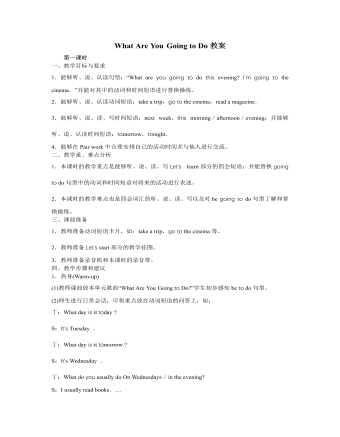
人教版新课标PEP小学英语六年级上册What Are You Going to Do教案
1.热身(Warm-up) (1)全班一起吟唱Let’s chant的歌谣。 (2)单词拼写竞赛 要拼写的单词包括:this morning/afternoon/evening,next week,newspaper, postcard等。可采取小组合作的“接龙式”拼写形式;也可以选取组内一名学生拼写全部单词。拼出单词最快最多的组获胜。 (3)教师出示简明地图,师生问答如下: r:What shop is it? s:It’s a bookstore. r:What can you buy in the bookstore? s:… 在学生回答各商店所出售的物品时,教师根据其回答贴出物品的小卡片,如: Fruit stand:orange,apple,pear,banana….Shoe store:sneakers,sandals,boots….(此时可引导学生说“a pair of sneakers/boots’’等) 2.预习(Preview) Let’s try 教师指着地图中的商店及各商店所出售的物品说:Look!There are so many stores and so many goods.Let’s listen to the tape and find out:①Where is Sarah going? ②What is she going to buy? ③Who is she going with? 教师放三遍Let’s try部分的录音,以上问题可根据学生的实际情况分三次提出,直到多数学生能回答并能将前两项答案填人教师课前画出的表格中。在填表过程中,教师请学生一起拼写其中的四会单词,如:bookstore,comic book。
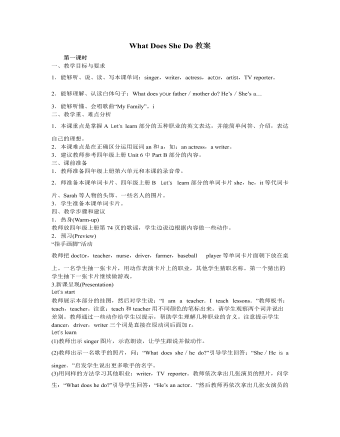
人教版新课标PEP小学英语六年级上册What Does She Do教案
(3)教师就黑板上的内容和学生做对话练习,如:What does your mother do?Where does she work?How does she go to work?教师板书“Where does she work?”和“How does she go to work?”,示范朗读,学生跟说。学生两人一组根据黑板上的语言提示做对话练习。 (4)“看卡片,说句子”活动 教师面前放一摞单词卡片,依次为:职业名称卡片,工作地点卡片和交通方式卡片。活动开始,教师随意从第一摞卡片中抽取一张职业卡片,如:engineer,举起来问:“What does your father do?”学生回答“He’s an engineer.”教师继续抽取一张工作地点卡片,举起来,如:Car company,问:“Where does he work?”学生说:“He works in a Car company.”教师再抽取一张交通方式卡片,如:bus,问:“How does he go to work?学生回答:“He go es to work by bus.”游戏进行几轮后,可以请几名学生轮流代替教师抽卡片,提问题。 (5)教师放本部分的录音,学生跟读。学生两人一组读课文对话。 (6)学生两人一组做对话替换练习。 (7)教师指导学生书写四会句子。 4.巩固和延伸(Consolidation and ex tension) Group work
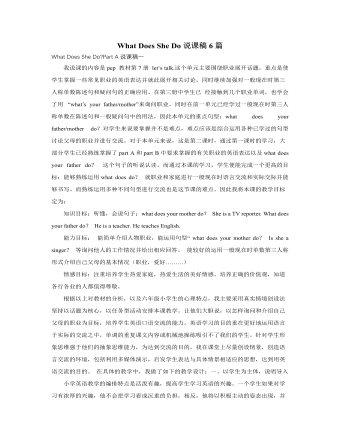
人教版新课标PEP小学英语六年级上册What Does She Do说课稿6篇
My Home本身就是一个与生活有着紧密联系的话题。我从这一点出发,紧紧围绕生活来开展教学。在Write and say这部分内容的教授中,我通过介绍我自己房间里的家具,如:Th is is my room, you can see a window、a door、a desk、a chair、a bed, Oh, It is a nice room . I like it,引出句型What can you see in my room ?引导学生说:I can see a window、a door、a desk、a chair、a bed, Oh, It is a nice room . I like it,然后安排同桌间拿出自己准备的房间图片,根据房间图片,相互之间询问。要求学生简单描述自己的房间,结合学过的语言描述房间内家具陈设的名称、特征等。学生看着自己亲手绘制的房间图片,亲切感、生活的真实感都一股脑儿地涌上心头。此时他们用学习的语言进行交流的愿望也就特别强烈。 最后、渗透情感教育 让学生通过谈论自己的房间,培养学生对家的热爱之情;我在这样的教学中渗透了学生热爱家庭的情感教育:因为,家是我们每个人永远的港湾,我们要爱家,爱护家里的每一样家具。
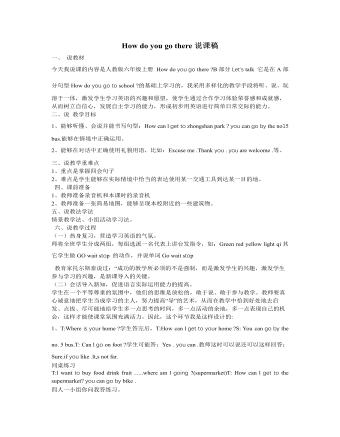
人教版新课标PEP小学英语六年级上册How do you go there说课稿
一、 说教材今天我说课的内容是人教版六年级上册 How do you go there ?B部分Let’s talk 它是在A部分句型How do you go to school ?的基础上学习的,我采用多样化的教学手段将听、说、玩溶于一体,激发学生学习英语的兴趣和愿望,使学生通过合作学习体验荣誉感和成就感,从而树立自信心,发展自主学习的能力,形成初步用英语进行简单日常交际的能力。二、说 教学目标1、能够听懂、会说并能书写句型:How can l get to zhongshan park ? you can go by the no15 bus.能够在情境中正确运用。2、能够在对话中正确使用礼貌用语,比如:Excuse me .Thank you . you are welcome .等。三、说教学重难点 1、重点是掌握四会句子2、难点是学生能够在实际情境中恰当的表达使用某一交通工具到达某一目的地。 四、课前准备 1、教师准备录音机和本课时的录音机2、教师准备一张简易地图,能够呈现本校附近的一些建筑物。
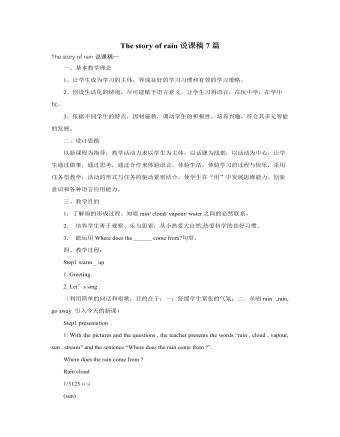
人教版新课标PEP小学英语六年级上册The story of rain说课稿7篇
4,在向学生提出了“ the water cycle”后,为了学生能够形象地解释,我马上播放flash “the water cycle”,5,通过观看flash “the water cycle”,学生已经能够理解水循环的意思,所以在理解的基础上,我出现了今天的chant,利用Chant的目的:1、记忆单词;2、熟悉新句型;3、使课堂更生动、活泼,让学生学得轻松。6,最后,播放了一个“一滴水”flash ,把本课的主题升华,让学生在一堂课中能够有所学有所悟。Water is useful(有用的). Let’s love it and protect(保护) it. Step 4 Homework在有限的时间里,通过练习作业本上的几个题目,来看看学生对本课的学习掌握了多少,同时也反馈给老师一些信息,看看本课哪些地方需要下一课时补充巩固一下。整堂课下来,自身受益匪浅,当然也发现了很多需要改进的地方,作为一个新教师,教学经验不足,课堂应变能力不强,教学用语生疏等等,希望在这里可能得到各位老师的指点和教导。
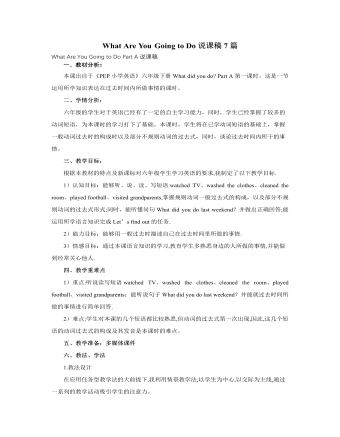
人教版新课标PEP小学英语六年级上册What Are You Going to Do说课稿7篇
四.说教学方法 “任务型”教学方法. 在本课的教学中,学生要完成购买书籍这样一个任务.这给学生创造了一个真实的语境去运用所学的句子进行交际.教师安排了4个活动:单词操练游戏、小组竞赛、小组活动和购物. 五.说教学准备 (一)教师准备:1.单词卡片。2.课件。3.各种书籍。 (二)学生准备:各种书籍. 六.说学习策略 在本节课上,学生可以通过多种方法来学习并记忆单词,如跟读、拼读、分音节、读看实物说单词、听单词拿实物等等.小组竞赛能激发学生的学习热情,鼓励学生表现自己. 七.说教学过程 一.复习和热身(Warm up) 1.唱英语歌曲. 2.朗读“口语天天练”的句子. 3.日常对话. 二.呈现新课(Presentation) 1.播放课件,呈现单词.学生跟读单词. 2.学习新单词. (1)教师带读单词,学生跟读. (2)拼读单词. (3)学生熟读单词.
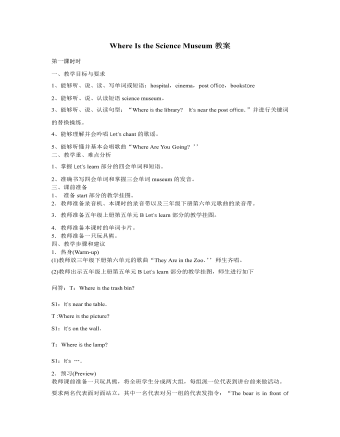
人教版新课标PEP小学英语六年级上册Where Is the Science Museum教案
3.新课呈现(Presentation) (1)教师将Let’s talk部分的教学挂图贴在黑板上说“1 want t0 go to the post office。。 Where is the post office? ”引导学生回答:“It’s east/west/south/north of …。? 接着让学生看挂图,利用图上出现的场所替换关键词进行问答。? (2)“爱我中华”活动 学生两人一组准备一张中国地图,进行问答,如:“Where is Jiangxi? It’s east 0f Hunan.It’s west of Zhejiang.It’s south of Anhui.It’s north of Guangdong.”等。 (3)教师将学生分成六组,仿照教学挂图所示位置,把六张单词卡片(hospital,bookstore,park,post office,cinema,sch001)分发给各组,然后教师站在图中Amy 的位置上,说:I want to go to the hospital.Where is it? ”学生会说:“It’s east of the park.’’教师再问:“How can I get there? ”引导学生说:“Turn left affil the cinema,and go straight.Then turn right at the post office and go straight-It’s on the left.”学生跟读并进行一系列的替换练习。 (4)教师放B Let’s talk部分的录音,学生跟读。 (5)学生两人一组,看地图,替换句型中的关键词自编对话,请几组学生表演对话。

人教版新课标PEP小学英语六年级上册How do you go there教案
教师检查有多少学生能够准确区分14与40的发音,如果答对率低,教师要注意纠正。教师还可以板书一组相似的数字,如:13/30,18/80,15/50,教师说英文,学生说出中文的数字,帮助学生区分/-ti:n/与l-u/。 3.新课呈现(Presentation) Let’s talk (1)教师根据学生平时常去的场所提问,如当地的一家电影院、风景点、或学生的祖父母家等:“How can you get to…? Can you go by …? Is it fast/slow/expensive to go by …? ”进行师生间的自由会话,再让学生感知一下新句型:How can I/ you get to…? 然后,教师请学生根据课本中提供的地图回答问题:“How can I get to Zhongshan Park? ”引导学生回答,提示他们坐15路公交车为:“By the No.15 bus.”教师提供完整的答句:“Yes.I can go by the No.15 bus.”教师板书这组句子。 (2)教师继续提问:“It’s a place.You can buy food,drink,fruit,veget ables,school things and clothes there.What is it? (It’s a supermarket.)”教师最好出示一张当地比较有名的超市的照片或图片来给出谜底。教师再提问:“How can I get there? By bus or by bike? ”然后领读句子:“I can go to the supermarket by …”帮助学生理解supermarket是一个合成词,来源于super与market。
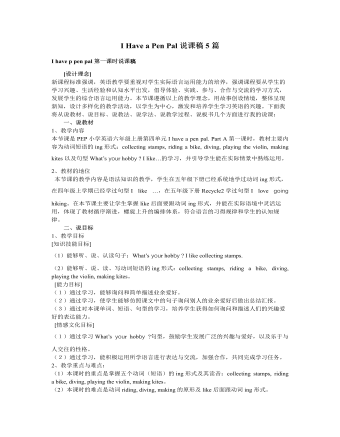
人教版新课标PEP小学英语六年级上册I Have a Pen Pal说课稿5篇
一、说教学思想我在本课教学设计中坚持以人文科技教育为中心,以学生为主体;以兴趣为支点、以交流为目的、以活动任务为途径的教学原则。通过最新的计算机多媒体等教学手段创造贴近生活的教学情境,并在课堂上大量地采用互动式教学模式(包括人机互动),使学生自然进入英语世界;在教学过程中,综合运用情景教学、任务型教学、交际教学、整体语言教学等手段,全面培养学生的听、说、读、写等语言综合运用能力。在课内、课外全面利用网络技术,如在线英语学习、博客(Blog)、魔灯(Moodle)、QQ群、论坛(BBS)等手段,做到英语与信息技术的完美整合。二、说教材与教材处理本课采用的教材是是人教版小学英语(PEP)六年级上册,内容为学生学完I Have a Pen Pal后的一节综合实践活动(复习)课。本单元教学重点为E-mail和英语书信的写法。通过该单元的学习,学生基本了解一些英语书信书写的方法。但是学生还没有利用计算机网络去写英文E-mail(包括写E-mail内容和写E-mail地址。)
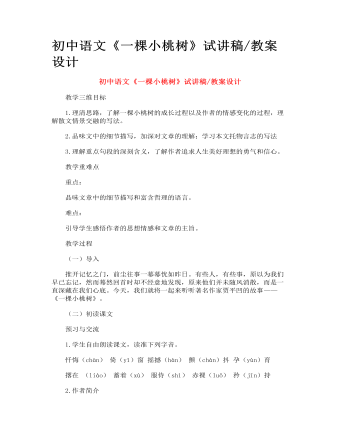
初中语文《一棵小桃树》试讲稿_教案设计
贾平凹,1952年2月21日生于陕西省商洛市丹凤县棣花镇,当代作家。 1974年开始发表作品。1975年毕业于西北大学中文系。1978年凭借《满月儿》,获得首届全国优秀短篇小说奖。1982年发表作品《鬼城》《二月杏》。1992年创刊《美文》。1993年创作《废都》。20**年,先后担任西安建筑科技大学人文学院院长、文学院院长。20**年凭借《秦腔》,获得第七届茅盾文学奖。20**年凭借《古炉》 ,获得施耐庵文学奖。20**年3月22日,澳门大学向贾平凹颁授了荣誉博士学位。
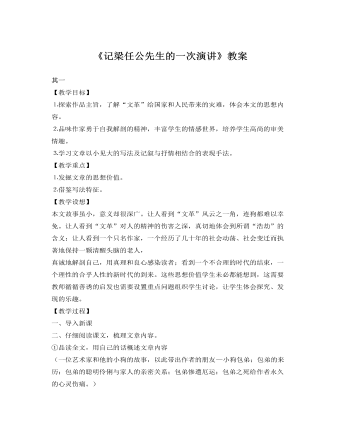
人教版高中语文《记梁任公先生的一次演讲》教案
十、教学后记:这是我实习中上的第一堂课,由于没有经验,对时间的把握不好,课堂前半部分留给学生思考回答问题的时间太多了,以至于没有完成本课时的教学内容,对《箜篌引》、《桃花扇》、《闻官军收河南河北》内容的补充要留到下节课才能完成。但课堂过程中以讨论和结果发布会的形式非常能调动学生的学习积极性,这节课学生的参与度很高,绝大部分的同学都能积极思考,并敢于回答问题。但是在学生回答问题后,有些答案很好,也是我没有思考到的。但是除了简单的表扬鼓励外,我不善于把学生的思考结果与自己的板书设计结合起来,授课过程中比较拘泥于教案,显得不够灵活。总的来说,这节课的优点是教态自然、大方,声音清晰洪亮,能调动学生学习的积极性,不足在于时间掌握不好,拘泥于教案。
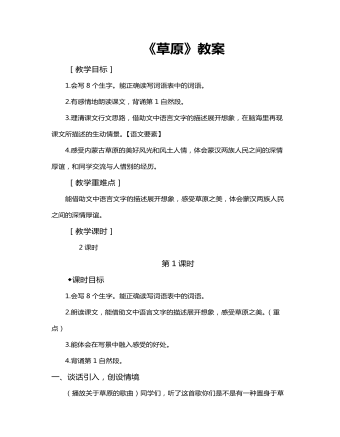
部编版六年级语文上册《草原》教案
(1)思考:作者是按什么顺序写的?写了哪些内容?明确:作者是按事情发展的先后顺序来写的。首先描述了一望无际的草原美景,使人感受到了一种境界美;接着又展示了主人欢迎远方客人的隆重场面;最后把酒话别,用“蒙汉情深何忍别,天涯碧草话斜阳”来收束全文。(板书:初到草原——远迎客人——热情相见——盛情款待——联欢话别)作者笔下的草原给你留下了什么印象?(学生讨论、交流自己的印象,可与读此文之前对草原的印象进行对比并探讨。)
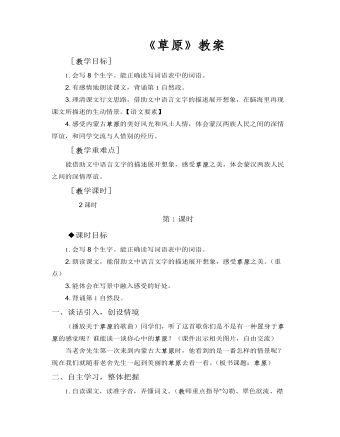
部编版六年级语文上册《草原》教案
1.会写8个生字。能正确读写词语表中的词语。2.朗读课文,能借助文中语言文字的描述展开想象,感受草原之美。(重点)3.能体会在写景中融入感受的好处。4.背诵第1自然段。一、谈话引入,创设情境(播放关于草原的歌曲)同学们,听了这首歌你们是不是有一种置身于草原的感觉呢?谁能谈一谈你心中的草原?(课件出示相关图片,自由交流)当老舍先生第一次来到内蒙古大草原时,他看到的是一番怎样的情景呢?现在我们就随着老舍先生一起到美丽的草原去看一看。(板书课题:草原)

